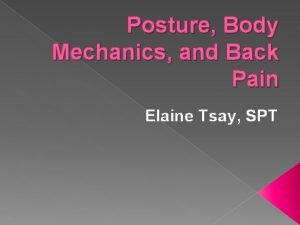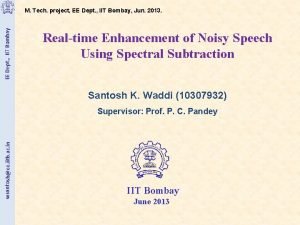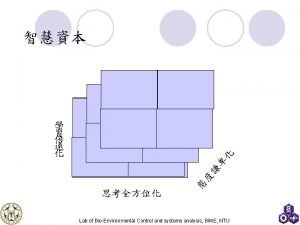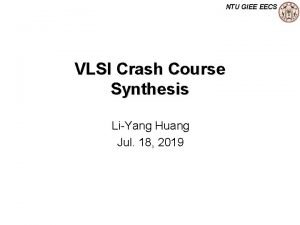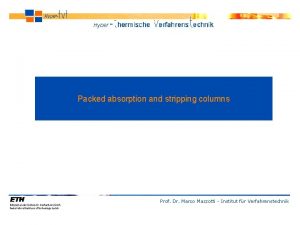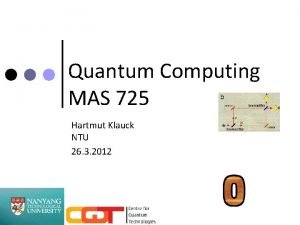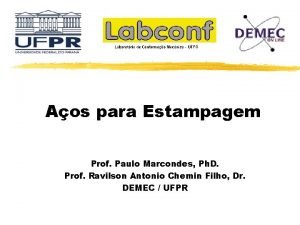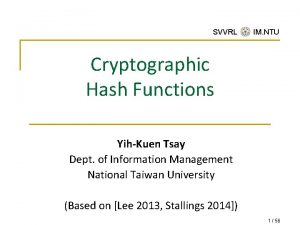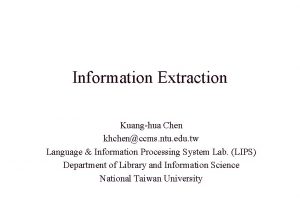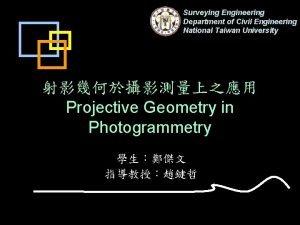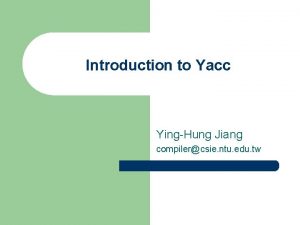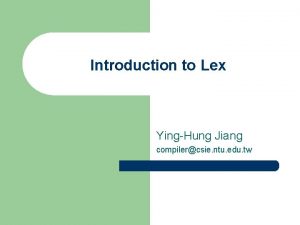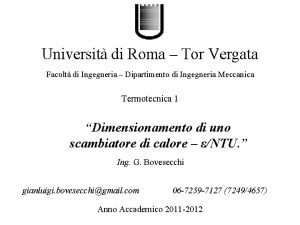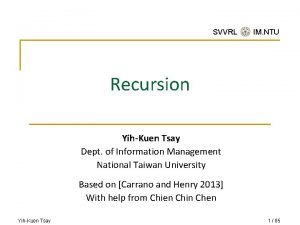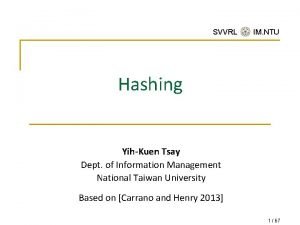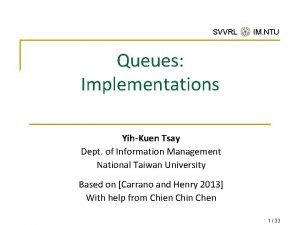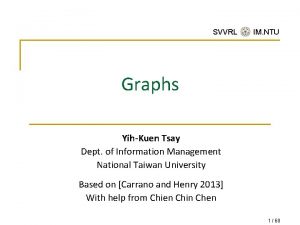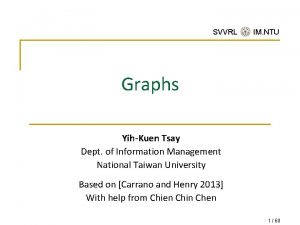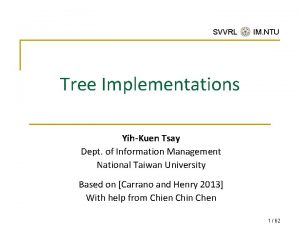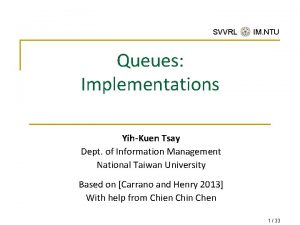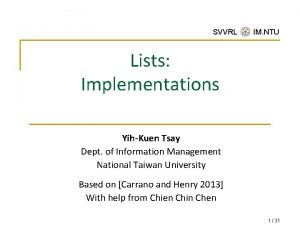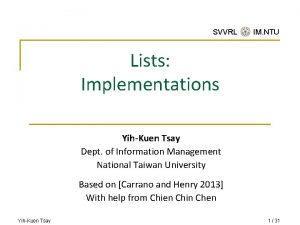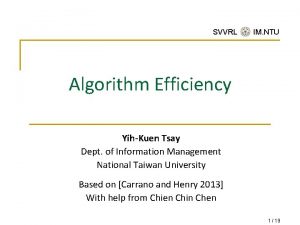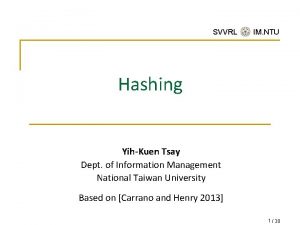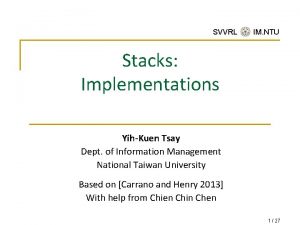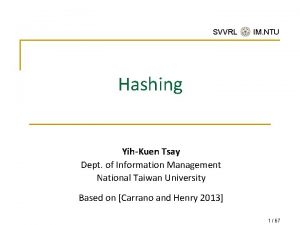SVVRL IM NTU Recursion YihKuen Tsay Dept of



















































































- Slides: 83

SVVRL @ IM. NTU Recursion Yih-Kuen Tsay Dept. of Information Management National Taiwan University Based on [Carrano and Henry 2013] With help from Chien Chin Chen 1 / 83

SVVRL @ IM. NTU The Basic Idea n n Recursion is an extremely powerful problemsolving technique. Recursion tries to q q break a problem into smaller identical problems. solve the problem by solving smaller instances of the same problem. (The solutions of the smaller problems will lead to the solution of the original problem. ) n Problems that at first appear to be quite difficult often have simple recursive solutions. Yih-Kuen Tsay DS 2015: Recursion 2 / 83

SVVRL @ IM. NTU An Example (1/2) n Looking up a word in a dictionary using binary search: Source: FIGURE 2 -1 in [Carrano and Henry 2013]. Yih-Kuen Tsay DS 2015: Recursion 3 / 83

SVVRL @ IM. NTU An Example (2/2) n The pseudocode: search(a. Dcitionary: Dictionary, word: string) if (a. Dictionary is one page in size) Scan the page for word else { Open a. Dictionary to a point near the middle Determine which half contains word if (word is in the first half of a. Dictionary) search(first half of a. Dictionary, word) else search(second half of a. Dictionary, word) } Yih-Kuen Tsay DS 2015: Recursion 4 / 83

Recursive Solutions (1/2) n n SVVRL @ IM. NTU Binary search reduces the problem of searching the dictionary for a word to a problem of searching half of the dictionary for the word. Two important points: q q Once you have divided the dictionary in halves, you already know how to search the appropriate half. There is a special case that is different from all the other cases: dictionary with a single page. n n Yih-Kuen Tsay Stop dividing and solve the problem directly. This special case is called the base case. DS 2015: Recursion 5 / 83

Recursive Solutions (2/2) n Binary search falls into the general category of divide and conquer. q q q n SVVRL @ IM. NTU You solve the dictionary search problem by first dividing the dictionary into two halves. And then conquering the appropriate half (a smaller problem). You solve the smaller problem by using the same divide-and-conquer strategy until you reach the base case. The concept of recursions is highly associated with this strategy. Yih-Kuen Tsay DS 2015: Recursion 6 / 83

SVVRL @ IM. NTU About Efficiency n n n The technique of recursion, though powerful, does not guarantee you an efficient solution. Some recursive solutions are so inefficient that they should not be used. We will come back to the efficiency issue later. Yih-Kuen Tsay DS 2015: Recursion 7 / 83

SVVRL @ IM. NTU Facts about a Recursive Solution n A recursive function calls itself. q n n Each recursive call solves an identical, but smaller, problem. The solution to at least one smaller problem— the base case—is known. q q n E. g. , the search function calls search(first/second half of a. Dictionary, word). When you reach the base case, the recursive calls stop and you solve the problem directly. E. g. , the function search scan the page for the word when the dictionary contains only one page. The diminishing size of the problem ensures that you will eventually reach the base case. Yih-Kuen Tsay DS 2015: Recursion 8 / 83

SVVRL @ IM. NTU Four Questions to Ask/Answer n n How can you define the problem in terms of smaller problems of the same type? How does each recursive call diminish the size of the problem? What instance(s) of the problem can serve as the base case? As the problem size diminishes, will you reach this base case? Yih-Kuen Tsay DS 2015: Recursion 9 / 83

SVVRL @ IM. NTU A Recursive Function: Factorial (1/4) n An iterative definition of factorial(n): factorial(n) = n * (n – 1) * (n – 2) * … * 1 for any integer n > 0 factorial(0) = 1 (Note: the factorial of a negative integer is undefined. ) n A recursive definition of factorial(n) = n * factorial(n– 1) =1 if n > 0 if n = 0 (Note: the base case is deliberately given later. ) Yih-Kuen Tsay DS 2015: Recursion 10 / 83

SVVRL @ IM. NTU A Recursive Function: Factorial (2/4) n It is easy to construct a C++ function that implements the definition. /** Computes the factorial of the nonnegative integer n. * @pre n must be greater than or equal to 0. * @post None. * @return The factorial of n; n is unchanged. */ int fact(int n) { base case if (n == 0) return 1; else return n * fact(n-1); } // end fact Yih-Kuen Tsay DS 2015: Recursion 11 / 83

SVVRL @ IM. NTU A Recursive Function: Factorial (3/4) n Does function fact fit the mold of a recursive solution? ü ü n One action of fact is to call itself. Each recursive fact diminishes the size of the problem by 1. factorial(0) is the base case. Given that n is nonnegative, you always reach the base case. Note that fact assumes the input n is nonnegative, as stated in its precondition. Yih-Kuen Tsay DS 2015: Recursion 12 / 83

SVVRL @ IM. NTU A Recursive Function: Factorial (4/4) cout << fact(3); 6 return 3*fact(2); 3*2 fact(n-1) is evaluated return 2*fact(1); 2*1 int fact(int n) { if (n == 0) return 1; else return n * fact(n-1); } // end fact Yih-Kuen Tsay return 1*fact(0); 1*1 base case return 1; DS 2015: Recursion 13 / 83

SVVRL @ IM. NTU Box Traces n n n A box trace is an illustration of how a compiler usually implements recursion. You may use it to help you understand recursion and to debug a recursive function. Each box in a box trace roughly corresponds to an “activation record. ” Yih-Kuen Tsay DS 2015: Recursion 14 / 83

SVVRL @ IM. NTU Constructing a Box Trace (1/7) 1. Label each recursive call in the body of the recursive function. q These labels help you keep track of the correct place to which you must return after a function call completes. int fact(int n) { if (n == 0) return 1; else return n * fact(n 1); (A) } Yih-Kuen Tsay DS 2015: Recursion 15 / 83

SVVRL @ IM. NTU Constructing a Box Trace (2/7) 2. During the course of an execution, represent each call to the function by a new box, containing: q q A copy of the actual value arguments. A placeholder for the value returned by each recursive call from the current box. n q q Label this placeholder to correspond to the label in Step 1. The value of the function itself. The function’s local variables. cout << fact(3); n = 3; A: factor(n-1) = ? return ? when you first create a box, you will know only the values of the input arguments. You fill in the values of the other items as you determine them from the function’s execution. Yih-Kuen Tsay DS 2015: Recursion 16 / 83

SVVRL @ IM. NTU Constructing a Box Trace (3/7) 3. When you create a new box after a recursive call, draw an arrow from the box that makes the call to the newly created box. o Label each arrow to correspond to the label of the recursive call. cout << fact(3); 4. n=3 A: fact(n-1) = ? return ? A n=2 A: fact(n-1) = ? return ? After you create the new box and arrow, start executing the body of the function. Yih-Kuen Tsay DS 2015: Recursion 17 / 83

SVVRL @ IM. NTU Constructing a Box Trace (4/7) 5. On existing the function, cross off the current box and follow its arrow back to the box that called the function. q Substitute the value returned by the just-terminated function call into the appropriate item the current box. Yih-Kuen Tsay … n=1 A: fact(n-1) = ? return ? … n=1 (current) A: fact(n-1) = ? 1 return? A n=0 (current) return 1 n=0 (cross off) return 1 DS 2015: Recursion 18 / 83

SVVRL @ IM. NTU Constructing a Box Trace (5/7) n When you return to point A and substitute the computed value for fact(n-1): q Continue execution by evaluating the expression return n * fact(n-1). … n=1 (current) A: fact(n-1) = 1 return? n=0 (cross off) return 1 if (n == 0) return 1; else return n * fact(n-1); (A) Yih-Kuen Tsay DS 2015: Recursion 19 / 83

SVVRL @ IM. NTU Constructing a Box Trace (6/7) n Box trace of fact(2): The initial call is made, and fact begins execution: n=2 A: fact(n-1)=? return ? int fact(int n) { if (n == 0) return 1; else return n * fact(n-1); (A) } At point A a recursive call is made, and the new invocation of fact begins execution: n=2 A: fact(n-1)=? return ? A n=1 A: fact(n-1)=? return ? A n=0 return ? This is the base case, so this invocation of fact completes: n=2 A: fact(n-1)=? return ? Yih-Kuen Tsay A n=1 A: fact(n-1)=? return ? A n=0 return 1 DS 2015: Recursion 20 / 83

SVVRL @ IM. NTU Constructing a Box Trace (7/7) The method value is returned to the calling box, which continues execution: n=2 n=1 n=0 A int fact(int n) A: fact(n-1)=? A: fact(n-1)=1 { if (n == 0) return ? return 1; else The current invocation of fact completes: return n * fact(n-1); n=2 n=1 n=0 A (A) } A: fact(n-1)=? A: fact(n-1)=1 return ? return 1 The method value is returned to the calling box, which continues execution: n=2 n=1 n=0 A: fact(n-1)=1 return ? return 1 The current invocation of fact completes: n=2 n=1 n=0 A: fact(n-1)=1 return 2 return 1 The value 2 is returned to the initial call. Yih-Kuen Tsay DS 2015: Recursion 21 / 83

SVVRL @ IM. NTU Invariants for Recursive Functions n Writing invariants for recursive functions is as important as writing them for iterative functions. q An invariant is a condition that is always true at a particular point in an algorithm/program. /** @pre n must be greater than or equal to 0 * @return the factorial of n. */ int fact(int n) { if (n == 0) return 1; else The recursive call satisfies fact’s precondition, so you // Invariant: n > 0, so n-1 >= 0. can expect from the post// Thus, fact(n-1) returns (n-1)! condition that fact(n-1) will return n * fact(n-1); return the factorial of n-1. } Yih-Kuen Tsay DS 2015: Recursion 22 / 83

SVVRL @ IM. NTU A Recursive Procedure: write. Backward (1/5) n Problem: q q n n Given a string of characters, write it in reverse order. E. g. , “cat” “tac”, “im” “mi” To construct a recursive solution, you should ask/answer the four questions. Note that a procedure is implemented as a “void function” in C++ (and several other languages). Yih-Kuen Tsay DS 2015: Recursion 23 / 83

SVVRL @ IM. NTU A Recursive Procedure: write. Backward (2/5) n Question 1: how can you define the problem in terms of smaller problems of the same type? q q Find a solution to the problem of writing a string of length n backward in terms of the solution to the problem of writing a string of length n – 1 backward. Which string of length n – 1? The ability to write a substring of length n – 1 backward, combined with the ability to perform some minor task, must result in the ability to write the original string backward. Which character to strip away? Yih-Kuen Tsay DS 2015: Recursion 24 / 83

SVVRL @ IM. NTU A Recursive Procedure: write. Backward (3/5) n Question 2: how does each recursive call diminish the size of the problem? q n The length of the string goes from n down to n – 1. Question 3: what instance of the problem can serve as the base case? q Write the empty string backward. n n Do nothing at all. Question 4: as the problem size diminishes, will you reach this base case? q Yes. Yih-Kuen Tsay DS 2015: Recursion 25 / 83

SVVRL @ IM. NTU A Recursive Procedure: write. Backward (4/5) n Consider stripping away the last character: q For the solution to be valid, you must write the last character in the string first. write. Backward(in s: string) if (the string is empty) Do nothing – this is the base case else { minor task Write the last character of s write. Backward(s minus its last character) } strip away the last character Yih-Kuen Tsay DS 2015: Recursion 26 / 83

SVVRL @ IM. NTU A Recursive Procedure: write. Backward (5/5) The C++ function write. Backward: n /** Writes a character string backward. * @pre The string s to write backward. * @post None. * @param s The string to write backward. */ void write. Backward(string s) { int length = s. size(); // Length of s if (length > 0) { // Write the last character cout << s. substr(length - 1, 1); } } // Write the rest of the string backward write. Backward(s. substr(0, length – 1)); // Point A // end if // length == 0 is the base case - do nothing // end write. Backward Yih-Kuen Tsay DS 2015: Recursion 27 / 83

SVVRL @ IM. NTU A Box Trace of write. Backward (1/3) n Box trace of write. Backward(“im”): q Each box contains the local environment of the recursive call: n n n The input argument s. The local variable length. No placeholder for the value returned by each recursive call or the value of the function itself. q Yih-Kuen Tsay Because the void function write. Backward does not use a return statement to return a computed value. DS 2015: Recursion 28 / 83

SVVRL @ IM. NTU A Box Trace of write. Backward (2/3) The initial call is made, and the function begins execution: s = “im” length = 2 Output line: m Point A (write. Backward(s. substr(0, length-1)) is reached, and the recursive call is made. The new invocation begins execution: s = “im” length = 2 A s = “im” length = 1 Output line: mi Point A is reached, and the recursive call is made. The new invocation begins execution: s = “im” length = 2 Yih-Kuen Tsay A s = “im” length = 1 A s = “im” length = 0 DS 2015: Recursion 29 / 83

SVVRL @ IM. NTU A Box Trace of write. Backward (3/3) This (length==0) is the base case, so this invocation completes. Control returns to the calling box, which continues execution: s = “im” length = 2 A s = “im” length = 1 s = “im” length = 0 This invocation completes. Control returns to the calling box, which continues execution: s = “im” length = 2 s = “im” length = 1 s = “im” length = 0 This invocation completes. Control returns to the statement following the initial call. Yih-Kuen Tsay DS 2015: Recursion 30 / 83

SVVRL @ IM. NTU An Alternative write. Backward (1/2) n How is the second alternative? q Strip away the first character: write. Backward 2(in s: string) if (the string is empty) Do nothing – this is the base case else { write. Backward 2(s minus its first character) Write the first character of s } Yih-Kuen Tsay DS 2015: Recursion 31 / 83

SVVRL @ IM. NTU An Alternative write. Backward (2/2) n When debugging (or tracing) a recursive function, try to use cout statements at the beginning, interior, and end of the function to report the values of local variables. write. Backward 2(s: string) cout << “Enter write. Backward 2 with string: “ << s << endl; if (the string is empty) Do nothing – this is the base case else { write. Backward 2(s minus its first character) // Point A cout << “About to write first character of string: ” << s << endl; Write the first character of s } cout << “Leave write. Backward 2 with string: “ << s << endl; Yih-Kuen Tsay DS 2015: Recursion 32 / 83

SVVRL @ IM. NTU A Box Trace of write. Backward 2 n Box trace of write. Backward 2(“im”): s=“im” s=“im” Yih-Kuen Tsay A A A s=“m” s=“im” A s=“” s=“m” s=“” Enter write. Backward 2 with string: im Enter write. Backward 2 with string: Leave write. Backward 2 with string: About to write first character of string: m m Leave write. Backward 2 with string: m About to write first character of string: im i Leave write. Backward 2 with string: im DS 2015: Recursion 33 / 83

SVVRL @ IM. NTU Searching an Array: Binary Search (1/8) n A high-level binary search: q Search a sorted array of integers for a given value. an. Array[0] <= an. Array[1] <= … <= an. Array[size-1] n binary. Search(an. Array: Array. Type, target: Item. Type) if (an. Array is of size 1) Determine if an. Array’s item is equal to target else { Find the midpoint of an. Array Determine which half of an. Array contains target if (target is in the first half of an. Array) binary. Search(first half of an. Array, target) else binary. Search(second half of an. Array, target) } Yih-Kuen Tsay DS 2015: Recursion 34 / 83

SVVRL @ IM. NTU Searching an Array: Binary Search (2/8) n How will you pass “half of an. Array” to the recursive calls to binary. Search? q q binary. Search(an. Array, first, last, target) n Pass the entire array at each call, but have binary. Search search only an. Array[first. . last]. The midpoint in [first. . last] is: n mid = (first + last) / 2 Then binary. Search(first half of an. Array, value): binary. Search(an. Array, first, mid-1, target) binary. Search(second half of an. Array, target): binary. Search(an. Array, mid+1, last, target) Yih-Kuen Tsay DS 2015: Recursion 35 / 83

SVVRL @ IM. NTU Searching an Array: Binary Search (3/8) n How do you determine which half of the array contains target? q q n The first half will be: if (target < an. Array[mid]). Remember to test the equality between target and an. Array[mid]. What should the base case(s) be? q target == an. Array[mid] n q When target is in the array. first > last n Yih-Kuen Tsay When target is not in the array. DS 2015: Recursion 36 / 83

SVVRL @ IM. NTU Searching an Array: Binary Search (4/8) n How will binary. Search indicate the result of the search? q q A negative value if it does not find target in the array. The index of the array item that is equal to target. Yih-Kuen Tsay DS 2015: Recursion 37 / 83

SVVRL @ IM. NTU Searching an Array: Binary Search (5/8) int binary. Search(const int an. Array[], int first, int last, int target) { int index; if (first > last) index = -1; // target not in original array Base cases. else { int mid = first + (last - first)/2; if (target == an. Array[mid]) index = mid; // value found at an. Array[mid] Yih-Kuen Tsay DS 2015: Recursion 38 / 83

SVVRL @ IM. NTU Searching an Array: Binary Search (6/8) Determine which half by comparison. else if (target < an. Array[mid]) // point X index = binary. Search(an. Array, first, mid 1, Specify the range of target); the half array. else } // point Y index = binary. Search(an. Array, mid+1, last, target); } // end if return index; // end binary. Search Yih-Kuen Tsay DS 2015: Recursion 39 / 83

SVVRL @ IM. NTU Searching an Array: Binary Search (7/8) n Box trace of binary. Search: q q an. Array = <1, 5, 9, 12, 15, 21, 29, 31> Search for 9. target = 9 first = 0 first = 2 last = 7 X last = 2 Y last = 2 mid = (0+7)/2 = 3 mid = (0+2)/2 = 1 mid = (2+2)/2 = 2 target < an. Array[3] target > an. Array[1] target = an. Array[2] X: binary. Search = 2 Y: binary. Search = 2 return 2 Yih-Kuen Tsay return 2 DS 2015: Recursion 40 / 83

SVVRL @ IM. NTU Searching an Array: Binary Search (8/8) n Box trace of binary. Search: q q an. Array = <1, 5, 9, 12, 15, 21, 29, 31> Search for 6. target = 6 first = 0 last = 7 mid = (0+7)/2 = 3 target < an. Array[3] X: binary. Search = -1 return -1 Yih-Kuen Tsay target = 6 first = 0 X last = 2 mid = (0+2)/2 = 1 target > an. Array[1] Y: binary. Search = -1 return -1 target = 6 first = 2 Y last = 2 mid = (2+2)/2 = 2 target < an. Array[2] X: binary. Search = -1 X first = 2 last = 1 first > last return -1 DS 2015: Recursion 41 / 83

SVVRL @ IM. NTU Searching an Array: Another Binary Search int binary. Search 2(const int an. Array[], int first, int last, int target) { int index; Base case. if (first == last) if (target == an. Array[first]) index = first; // target found at an. Array[first] else index = -1; // target not in original array else { int mid = first + (last - first)/2; if (target < an. Array[mid]) index = binary. Search 2(an. Array, first, mid-1, target); else index = binary. Search 2(an. Array, mid, last, target); } return index; } Yih-Kuen Tsay DS 2015: Recursion 42 / 83

SVVRL @ IM. NTU Searching an Array: the Largest Item (1/2) n A recursive solution if (an. Array has only one entry) max. Array(an. Array) is the item in an. Array else if (an. Array has more than one item) max. Array(an. Array) is the maximum of max. Array(left half of an. Array) and max. Array(right half of an. Array) Source: FIGURE 2 -12 in [Carrano and Henry 2013] Yih-Kuen Tsay DS 2015: Recursion 43 / 83

SVVRL @ IM. NTU Searching an Array: the Largest Item (2/2) max. Array(<1, 6, 8, 3>) = 8 return max( max. Array(<1, 6>), max. Array(<8, 3>) ) 6 max. Array(<1, 6>) return max( max. Array(<1>), max. Array(<6>) ) 1 max. Array(<1>) return 1 Yih-Kuen Tsay 6 max. Array(<6>) return 6 8 max. Array(<8, 3>) return max( max. Array(<8>), max. Array(<3>) ) 8 max. Array(<8>) return 8 DS 2015: Recursion 3 max. Array(<3>) return 3 44 / 83

SVVRL @ IM. NTU Searching an Array: the kth Smallest Item (1/4) n You can solve this problem by sorting the array. q n A more efficient solution is possible. q n Then the kth smallest item would be an. Array[k-1]. Without completely sorting the array. The recursive solution proceeds by: q q q Selecting a pivot item in the array. Cleverly arranging, or partitioning, the items in the array about this pivot item. Recursively applying the strategy to one of the partitions. Yih-Kuen Tsay DS 2015: Recursion 45 / 83

SVVRL @ IM. NTU Searching an Array: the kth Smallest Item (2/4) n Suppose that you want to find the kth smallest item in the array segment an. Array[first. . . last]: q n n n Let p be any item of the array segment. If S 1 contains k-1 items: k = pivot. Index – first + 1. If S 1 contains k or more items: k < pivot. Index – first + 1. If S 1 contains fewer than k-1 items (S 1 & p contains fewer than k items): k > pivot. Index – first + 1. Yih-Kuen Tsay DS 2015: Recursion 46 / 83

SVVRL @ IM. NTU Searching an Array: the kth Smallest Item (3/4) n Let k. Small(k, an. Array, first, last) = kth smallest item in an. Array[first. . last] n Solution: k. Small(k, an. Array, first, last) = k. Small(k, an. Array, first, pivot. Index-1) if k < pivot. Index – first + 1 = p if k = pivot. Index – first + 1 = k. Small(k-(pivot. Index-first+1), an. Array, pivot. Index+1, last) if k > pivot. Index – first + 1 Yih-Kuen Tsay DS 2015: Recursion the base case 47 / 83

SVVRL @ IM. NTU Searching an Array: the kth Smallest Item (4/4) n Two more questions: q How to choose the pivot item p? n q The choice of p is arbitrary. How to partition the array? n Yih-Kuen Tsay Chapter 11 gives an algorithm for partitioning the array. DS 2015: Recursion 48 / 83

The Towers of Hanoi (1/11) n SVVRL @ IM. NTU Rules: q q q To move n disks, one by one, from pole A to pole B. Pole C can be used for the help of the transfer. A disk could be placed only on top of a larger disk. (source) Yih-Kuen Tsay (destination) DS 2015: Recursion (spare) 49 / 83

The Towers of Hanoi (2/11) n SVVRL @ IM. NTU Recursive thinking: q If you have only one disk (that is, n=1): n q Move it from source to destination directly. If you have more than one disk (that is, n>1): n Ignore the bottom disk and solve the problem for n-1 disks, with the small modification that pole C is the destination and pole B is the spare. (source) Yih-Kuen Tsay (spare) (destination) DS 2015: Recursion 50 / 83

The Towers of Hanoi (3/11) n SVVRL @ IM. NTU Then, solve the problem for n=1 by moving the largest disk from A to B. (source) Yih-Kuen Tsay (destination) DS 2015: Recursion (spare) 51 / 83

The Towers of Hanoi (4/11) n SVVRL @ IM. NTU Now, all you have to do is move the n-1 disks from pole C to pole B. q C as the source, B as the destination, and A as the spare. (spare) Yih-Kuen Tsay (destination) DS 2015: Recursion (source) 52 / 83

The Towers of Hanoi (5/11) n SVVRL @ IM. NTU Pseudocode: solve. Towers(count, source, destination, spare) the base case if (count is 1) Move a disk directly from source to destination else { solve. Towers(count-1, source, spare, destination) solve. Towers(1, source, destination, spare) solve. Towers(count-1, spare, destination, source) } // end if Meet the four questions ? Yih-Kuen Tsay DS 2015: Recursion 53 / 83

SVVRL @ IM. NTU The Towers of Hanoi (6/11) 1 solve. Towers(3, A, B, C) 2 7 6 solve. Towers(2, A, C, B) solve. Towers(1, A, B, C) solve. Towers(2, C, B, A) 3 solve. Towers(1, A, B, C) 4 8 solve. Towers(1, C, A, B) 9 solve. Towers(1, A, C, B) 5 solve. Towers(1, C, B, A) 10 solve. Towers(1, B, C, A) solve. Towers(1, A, B, C) : base case, move disk from source to destination directly. Yih-Kuen Tsay DS 2015: Recursion 54 / 83

The Towers of Hanoi (7/11) n n SVVRL @ IM. NTU With N disks, how many moves does solve. Towers make? Let moves(N) be the number of moves made starting with N disks. q q When N = 1, moves(1) = 1. When N > 1, moves(N) = moves(N– 1) + moves(N– 1). Yih-Kuen Tsay DS 2015: Recursion 55 / 83

The Towers of Hanoi (8/11) n SVVRL @ IM. NTU Recurrence relation for the number of moves that solve. Towers requires for N disks: moves(N) = 1, if N = 1, = 2 * moves(N – 1) + 1, if N > 1. Example: moves(3) = = Yih-Kuen Tsay 2 * moves(2) + 1 2 * (2 * moves(1) + 1 2 * (2 * 1 + 1) + 1 7 DS 2015: Recursion 56 / 83

The Towers of Hanoi (9/11) n SVVRL @ IM. NTU Although the recurrence relation gives you a way to compute moves(N), A closed-formula is more satisfactory. q Closed-formula: such as an algebraic expression. With the formula, you can substitute any given value for N and obtain the number of moves made. q moves(N) = 2 N – 1, for all N ≥ 1. q n Yih-Kuen Tsay E. g. , moves(3) = 23 – 1 = 8 – 1 = 7. DS 2015: Recursion 57 / 83

The Towers of Hanoi (10/11) N = 1 1 N = 2 1 : move the disk once from source to destination directly. SVVRL @ IM. NTU 1 move 1 3 moves N=1 N = 3 N=1 1 1 7 moves N=2 1 1 Yih-Kuen Tsay 1 1 DS 2015: Recursion moves(N) equals to the numer of nodes in a binary tree. 2 N-1 58 / 83

The Towers of Hanoi (11/11) n SVVRL @ IM. NTU The towers of Hanoi is a very difficult problem. N moves(N) Time 2 3 3 seconds 3 7 7 seconds 4 15 15 seconds 10 1023 17 minutes double moves 11 20 2047 34 minutes 1048575 12 days!! 1025 times The recursive solve. Towers is an exponential algorithm. Yih-Kuen Tsay DS 2015: Recursion 59 / 83

The Fibonacci Sequence (1/5) (Multiplying Rabbits) n SVVRL @ IM. NTU “Facts” about rabbits: q q q Rabbits never die. A rabbit reaches sexual maturity exactly two months after birth, that is, at the beginning of its third month of life. Rabbits are always born in male-female pairs. At the beginning of every month, each sexually mature malefemale pair gives birth to exactly one male-female pair. Yih-Kuen Tsay DS 2015: Recursion 60 / 83

The Fibonacci Sequence (2/5) n Problem: q How many pairs of rabbits are alive in month n? n n SVVRL @ IM. NTU Started with a single newborn male-female pair. Recurrence relation: rabbit(n) = rabbit(n – 1) + rabbit(n – 2). old members: the number of pairs alive just prior to the month n. n new members: the number of pairs born at the start of month n. Differences to the previous examples: q You can solve a problem by solving more than one smaller problem of the same type. Yih-Kuen Tsay DS 2015: Recursion 61 / 83

The Fibonacci Sequence (3/5) n SVVRL @ IM. NTU When you employ more than one recursive call in problem solving, you must be very careful when selecting the base case. q q Assume rabbit(1) = 1 is the base case. Then rabbit(2) = rabbit(1) + rabbit(0). Keep recursive rabbit(-1), rabbit(-2) … Violate the question 4, will you reach the base case? n You have to define more than one base case. q Either rabbit(0) = 0 or rabbit(2) = 1. Yih-Kuen Tsay DS 2015: Recursion 62 / 83

The Fibonacci Sequence (4/5) n Base cases: rabbit(2), rabbit(1). n Recursive definition: SVVRL @ IM. NTU rabbit(n) = 1 if n is 1 or 2 = rabbit(n – 1) + rabbit(n – 2) if n > 2 n Fibonacci sequence q q The series of numbers rabbit(1), rabbit(2), rabbit(3), and so on; that is, 1, 1, 2, 3, 5, 8, 13, … Which models many naturally occurring phenomena. Yih-Kuen Tsay DS 2015: Recursion 63 / 83

The Fibonacci Sequence (5/5) n SVVRL @ IM. NTU A C++ function to compute rabbit(n): /** Computes a term in the Fibonacci sequence. * @pre n is a positive integer. (n > 0) * @post None. * @param n The given integer. * @return The nth Fibonacci number. */ int rabbit(int n) { if (n <= 2) return 1; else // n > 2, so n-1 > 0 and n-2 > 0 return rabbit(n-1) + rabbit(n-2); } Yih-Kuen Tsay DS 2015: Recursion 64 / 83

Organizing a Parade (1/3) n Problem: q q q n How many ways can you organize a parade of length n? The parade will consist of bands and floats in a single line. One band cannot be placed immediately after another. Let q q q n SVVRL @ IM. NTU P(n): the number of ways to organize a parade of length n. F(n): the number of parades of length n ending with a float. B(n): the number of parades of length n ending with a band. Then P(n) = F(n) + B(n). Yih-Kuen q Tsay DS 2015: Recursion 65 / 83

Organizing a Parade (2/3) n F(n) = P(n – 1) q n You can have a parade of length n that ends with a float simply by placing a float at the end of any acceptable parade of length n-1. B(n) = F(n – 1) q q n SVVRL @ IM. NTU The only way a parade can end with a band is if the unit just before the end is a float. Or, B(n) = P(n - 2). Number of acceptable parades of length n q P(n) = F(n) + B(n) = P(n – 1) + P(n – 2) Yih-Kuen Tsay DS 2015: Recursion 66 / 83

Organizing a Parade (3/3) n Again, two base cases are necessary. n Base cases: SVVRL @ IM. NTU P(1) = 2 (The parades of length 1 are float and band. ) P(2) = 3 (The parades of length 2 are float-float, bandfloat, and float-band. ) n Solution: P(n) = 2 for n = 1 =3 for n = 2 recurrence relation =The P(n – 1) + P(n – 2)is identical for ton rabbit, >2 but the base cases are different. Yih-Kuen Tsay DS 2015: Recursion 67 / 83

SVVRL @ IM. NTU Choosing k out of n Things (1/6) n Problem: q n How many different choices are possible for exploring k planets out of n planets in a solar system? Let g(n, k) be the number of groups of k planets chosen from n. q In terms of Planet X: g(n, k) = the number of groups of k planets that include Planet X + the number of groups of k planets that do not include Planet X Yih-Kuen Tsay DS 2015: Recursion 68 / 83

SVVRL @ IM. NTU Choosing k out of n Things (2/6) n g(n, k) = g(n – 1, k – 1) + g(n – 1, k) Including X, the number of ways to choose k – 1 out of n – 1 n Not including X, the number of ways to choose k out of n – 1 Base cases: q g(k, k) = 1. There is one group of everything. n Yih-Kuen Tsay Will you reach this base case? q If n > k, it is easy to see that the second term in the recursive definition (g(n-1, k)) is closer to the base case g(k, k) than is g(n, k). q However, the first term (g(n-1, k-1)) is not closer to g(k, k) than is g(n, k) — they are the same distance apart. DS 2015: Recursion 69 / 83

SVVRL @ IM. NTU Choosing k out of n Things (3/6) n g(n, 0) = 1. There is one group of nothing. q n We have shown that, when n > k, the two terms in the recursive definition would eventually reach a base case. q n If n > k, the first term g(n-1, k-1) is closer to it than g(n, k). But … what if n < k? g(n, k) = 0 if k > n. Although k cannot exceed n here, we want our solution to be general. Yih-Kuen Tsay DS 2015: Recursion 70 / 83

SVVRL @ IM. NTU Choosing k out of n Things (4/6) n Recursive solution: g(n, k) = 1 1 0 g(n – 1, k – 1) + g(n – 1, k) Yih-Kuen Tsay DS 2015: Recursion if k = 0 if k = n if k > n if 0 < k < n 71 / 83

SVVRL @ IM. NTU Choosing k out of n Things (5/6) n A C++ function to compute g(n, k): /** Computes the number of groups of k out of n things. * @pre n and k are nonnegative integers. * @post None. * @param n The given number of things. * @param k The given number to choose. * @return g(n, k). */ int g(int n, k) { if( (k == 0) || (k == n) ) return 1; else if (k > n) return 0; else return g(n-1, k-1) + g(n-1, k); } Yih-Kuen Tsay DS 2015: Recursion 72 / 83

SVVRL @ IM. NTU Choosing k out of n Things (6/6) n g(4, 2) = 6 g(4, 2) return g(3, 1) + g(3, 2) 3 g(3, 1) return g(2, 0) + g(2, 1) 1 g(2, 0) return 1 2 g(2, 1) return g(1, 0) + g(1, 1) g(1, 0) return 1 Yih-Kuen Tsay g(3, 2) Return g(2, 1) + g(2, 2) 2 1 3 1 g(1, 1) return 1 1 g(2, 1) return g(1, 0) + g(1, 1) 1 g(1, 0) return 1 DS 2015: Recursion 1 g(2, 2) return 1 g(1, 1) return 1 73 / 83

SVVRL @ IM. NTU Recursion and Efficiency (1/4) n n Recursion is a powerful problem-solving technique that often produces very clear solutions to complex problems. Some recursive solutions are so inefficient that they should not be used. q n binary. Search and solve. Towers are exceptions; they are quite efficient. Factors that contribute to the inefficiency of some recursive solutions: q q Overhead associated with function calls. Inherent inefficiency of some recursive algorithms. Yih-Kuen Tsay DS 2015: Recursion 74 / 83

SVVRL @ IM. NTU Recursion and Efficiency (2/4) n In most programming languages, a function call incurs a bookkeeping overhead. q q Local variables, the returning address, … etc. Recursive functions can generate a lot of recursive calls magnify this overhead. Yih-Kuen Tsay DS 2015: Recursion 75 / 83

SVVRL @ IM. NTU Recursion and Efficiency (3/4) n An example of inefficient recursive algorithms: q c(n, k) = c(n – 1, k – 1) + c(n – 1, k) Source: FIGURE 2 -20 in [Carrano and Henry 2013]. Yih-Kuen Tsay DS 2015: Recursion 76 / 83

SVVRL @ IM. NTU Recursion and Efficiency (4/4) n n Do not use a recursive solution if it is inefficient and there is a clear, efficient iterative solution. You may need to convert a recursive solution to an iterative solution. void write. Backward(string s) { int length = s. size(); if (length > 0) { cout << s. substr(length-1, 1); write. Backward(s. substr(0, length-1)); } } void write. Backward(string s) { int length = s. size(); while (length > 0) { cout << s. substr(length-1, 1); length--; } } Tail recursion: the recursive call is the last action that the function takes. Yih-Kuen Tsay DS 2015: Recursion 77 / 83

SVVRL @ IM. NTU Summary (1/2) n n Recursion solves a problem by solving smaller problems of the same type. Four questions: q q How can you define the problem in terms of smaller problems of the same type? How does each recursive call diminish the size of the problem? What instance(s) of the problem can serve as the base case? As the problem size diminishes, will you reach a base case? Yih-Kuen Tsay DS 2015: Recursion 78 / 83

SVVRL @ IM. NTU Summary (2/2) n n n A box trace can be used to trace the actions of a recursive method. Some recursive solutions are much less efficient than a corresponding iterative solution due to their inherently inefficient algorithms and the overhead of function calls. If you can easily, clearly, and efficiently solve a problem by using iteration, you should do so. Yih-Kuen Tsay DS 2015: Recursion 79 / 83

SVVRL @ IM. NTU Remarks (1/4) n n “Recursive thinking” should be better repositioned as “inductive thinking. ” Inductive thinking tries to solve a problem in essentially the same way as recursive thinking. More importantly, induction is associated with principles of precise mathematical reasoning. Basically, when you have a positive answer to each of the “four questions” for recursion, you have a proper induction. Yih-Kuen Tsay DS 2015: Recursion 80 / 83

SVVRL @ IM. NTU Remarks (2/4) n When you use induction backward, you get recursive solutions (as you have seen). /** Computes a term in the Fibonacci sequence. * @pre n is a positive integer. (n > 0) * @post None. * @param n The given integer. * @return The nth Fibonacci number. */ int rabbit(int n) { if (n <= 2) return 1; else // n > 2, so n-1 > 0 and n-2 > 0 return rabbit(n-1) + rabbit(n-2); } Yih-Kuen Tsay DS 2015: Recursion 81 / 83

Remarks (3/4) n SVVRL @ IM. NTU When you use induction forward, you get iterative solutions. int rabbit_iterative(int n) { // Declarations of locals omitted. if (n <= 2) return 1; else { fn_2 = 1; fn_1 = 1; for (i = 3; i <= n; i++) { fn = fn_2 + fn_1; fn_2 = fn_1; fn_1 = fn; } return fn; } Yih-Kuen Tsay DS 2015: Recursion } 82 / 83

SVVRL @ IM. NTU Remarks (4/4) n Why does induction work? q Many data sets have natural inductive definitions. n q Functions from such a data set to another data set also have natural inductive definitions. n q n Examples: the natural numbers, lists, binary trees Examples: “factorial of n”, “n-th Fibonacci number”, “length of a list”, “number of tree nodes” Such inductive definitions provide the basis for simple and effective solutions. Finally, it is often possible to attain efficiency, while maintaining the simplicity of the solution. Yih-Kuen Tsay DS 2015: Recursion 83 / 83
 To understand recursion you must understand recursion
To understand recursion you must understand recursion Elaine tsay
Elaine tsay Yih-kuen tsay
Yih-kuen tsay City of worcester inspectional services
City of worcester inspectional services Albany county dss
Albany county dss Dept of education
Dept of education Nys department of homeland security
Nys department of homeland security Oviposition
Oviposition Dept. name of organization (of affiliation)
Dept. name of organization (of affiliation) Dept nmr spectroscopy
Dept nmr spectroscopy Nebraska dept of agriculture
Nebraska dept of agriculture Dept a
Dept a Gome dept
Gome dept Gome dept
Gome dept Dept. name of organization (of affiliation)
Dept. name of organization (of affiliation) Bromocicloesano
Bromocicloesano La dept of revenue
La dept of revenue Dept of education
Dept of education Ohio employment first
Ohio employment first Florida dept of agriculture and consumer services
Florida dept of agriculture and consumer services Iit
Iit Central islip fire department
Central islip fire department Hoe dept
Hoe dept Mn dept of education
Mn dept of education Pt dept logistik
Pt dept logistik La geaux biz
La geaux biz Florida dept of agriculture and consumer services
Florida dept of agriculture and consumer services Affiliation poster presentation
Affiliation poster presentation Gome dept
Gome dept Finance department organizational chart
Finance department organizational chart Dept ind onegov
Dept ind onegov Rowan county dss child protective services
Rowan county dss child protective services Fire dept interview questions
Fire dept interview questions Dept of finance and administration
Dept of finance and administration Rewley house continuing education library
Rewley house continuing education library Florida dept of agriculture and consumer services
Florida dept of agriculture and consumer services Vaginal dept
Vaginal dept Nyttofunktion
Nyttofunktion Ntu bime
Ntu bime Ntu in networking
Ntu in networking Marginal fail ntu
Marginal fail ntu Ntu
Ntu Ntu
Ntu Ntu ie
Ntu ie Ntu giee
Ntu giee Ntu-rgbd
Ntu-rgbd Ntu cits helpdesk
Ntu cits helpdesk Ntu htu
Ntu htu Ntu quantum computing
Ntu quantum computing Yeh-ching chung
Yeh-ching chung Parallel flow heat exchanger
Parallel flow heat exchanger Hwu webmail
Hwu webmail Ntu cisco
Ntu cisco Aço ntu-qc-250
Aço ntu-qc-250 Ntu csie
Ntu csie Acceler8 ntu
Acceler8 ntu Ntu csie vpn
Ntu csie vpn Ntu hpap
Ntu hpap Ntu
Ntu Ntu faq
Ntu faq Ntu lis
Ntu lis Student dashboard ntu
Student dashboard ntu Heat exchange
Heat exchange Ntu matlab
Ntu matlab Ntu ce
Ntu ce Slidetodoc.com
Slidetodoc.com Ntu lhs
Ntu lhs Eportfolio ntu
Eportfolio ntu Ntu cc
Ntu cc Ntu csie
Ntu csie Ntu rx
Ntu rx Hwu timetable
Hwu timetable Ntu scambiatore
Ntu scambiatore Lt19 ntu
Lt19 ntu Belgrave ntu
Belgrave ntu Ntu microsoft
Ntu microsoft Lams ntu
Lams ntu Ntu heat transfer
Ntu heat transfer Ntu google map
Ntu google map 吳安宇
吳安宇 Csie.ntu
Csie.ntu Nora ntu
Nora ntu Hkmc vpn
Hkmc vpn Dion goh ntu
Dion goh ntu

